A Very Different Walk
Night Walk on More Mesa: Continuing with our “Walk on More Mesa” theme, a very different kind of walk presented itself in late September. Jennifer Stroh of the Land Trust for Santa Barbara County invited me to an informal walk that was not only on the west side of More Mesa, but it was a night walk as well! Since I had never experienced a night walk that focused on nocturnal animals, I was eager to participate.
Our leader was Ted Mullen, a Senior Biologist, graduate of UCSB, and currently a scientist with MRS Environmental, here in Santa Barbara. As soon as we headed out onto More Mesa, Ted launched our adventure with a lesson in listening … a key skill when there is little, or no, light; and especially important when one is trying to identify birds and animals that hunt at night. He talked about identifying all the various sounds (man made and otherwise) and then sorting them out from one another. And, although the man-made intrusions on More Mesa are somewhat limited, he pointed out two important ones:
- The “drone” sound of freeway and other traffic, and how that background noise affects the ability of hunting animals to hear sounds that are vitally important to them; for example sounds of rodents and other prey moving through the grasses. We did note, however, that the “drone” was not as obvious, or even discernible, in all the parts of More Mesa that we visited.
- The intrusion of street lights from neighboring communities, and how they would also affect the ability to hunt … especially for the owls that make their homes on the north facing side of More Mesa.
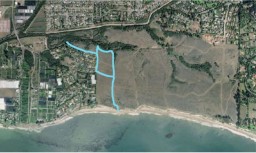
At the beginning of the walk, on the northwestern edge of More Mesa, we heard three species of Owls: Barn, Great Horned and Screech. Then Ted surprised some of us by noting that Screech Owls did not screech at all, and proved it by playing several of their calls. We were also treated to the sight of an owl flying quite close to us.
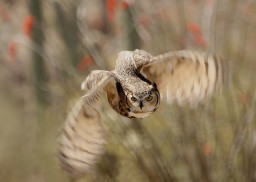
Photo by Larry Friesen
One of the “owl” stories Ted told, and one that I got a big chuckle out of, concerned Great Horned nest building. The Great Horned, being a bigger bird, hunts larger animals, like rabbits and skunks. Moreover, skunks are regularly on their menu because, unlike the rest of us, the Great Horned is not bothered, at all, with the stench of skunk spray. Ever-vigilant parents, the Great Horned will therefore sometimes line their nest with skunk carcasses. This clever strategy prevents predators from being tempted to carry off the chicks … because most of the rest of the world is definitely not fond of skunk spray!
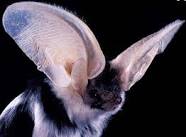
As our walk progressed towards the coast, we saw and heard Spotted Bats and, at one point, we even heard a Towhee; a bird that should have been asleep. Maybe we woke it up … or something else woke it up?
The sky was brilliant and clear. Amateur astronomers had a blast and we even got to see all the lobster boats out on the first day of the season. It was an absolutely wonderful walk and I was privileged to be part of it.
How You Can Help
Our coalition very rarely solicits donations from our supporters, only in times of real need. While More Mesa is not in immediate jeopardy (no building plan has yet been submitted to planning), we spend additional funds to remain in a “ready state” for when the developers make their move.
That means continuing to build and maintain a database of supporters who can help us by contacting their elected officials, testifying at hearings, recruiting their friends, contacting the media and coming together for a show of community support. Lastly, we maintain a small contingency budget so that we can react quickly when the time arises.
Our immediate expenses for the next year are not large (unless things change with development plans), no more than $5,000. But without those funds to replenish our budget we could be flat-footed the day the development plan is filed.
I am sure that you support many other important causes; I just wanted to put in my request for the White-tailed Kites, the Great Horned Owls, the Red-tailed Hawks … and even the Spotted Bats of More Mesa. A gift of $50 or $100 to keep us in a ready state would be terrific.
Thank you so much, from all the critters of More Mesa.


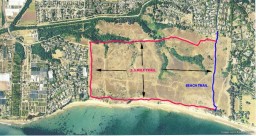
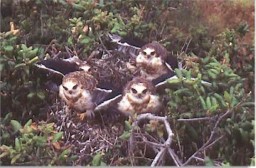
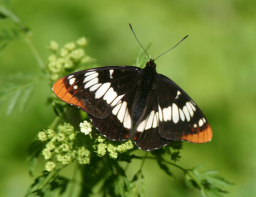
 So what did happen in June 1859? According to Tompkins, it was about 80 F by noon on that fateful day… a little high for our lovely Goleta Valley … known for its moderate temperatures. Then, about 1 PM according to Tompkins, a ‘blast of superheated air’ came from the direction of Santa Ynez Peak and hit the Goleta Valley, alarming the residents and sending them scurrying for cover inside thick-walled buildings. Tompkins wrote that by 2 PM the temperature had reached an incredible 133 F, with the northwest wind bringing ‘great clouds of impalpable dust’. People reportedly took refuge in several places including behind the 3-foot-thick walls of the Daniel Hill adobe. Calves, rabbits, and cattle died on their feet according to a “government report”, and fruit fell from trees to the ground, scorched on the windward side. Birds fell dead from the sky and others flew into wells in search of cooler air and drowned. About 5 PM the searing, hot wind died down, the report said, the thermometer ‘cooled off’ to 122 F.
So what did happen in June 1859? According to Tompkins, it was about 80 F by noon on that fateful day… a little high for our lovely Goleta Valley … known for its moderate temperatures. Then, about 1 PM according to Tompkins, a ‘blast of superheated air’ came from the direction of Santa Ynez Peak and hit the Goleta Valley, alarming the residents and sending them scurrying for cover inside thick-walled buildings. Tompkins wrote that by 2 PM the temperature had reached an incredible 133 F, with the northwest wind bringing ‘great clouds of impalpable dust’. People reportedly took refuge in several places including behind the 3-foot-thick walls of the Daniel Hill adobe. Calves, rabbits, and cattle died on their feet according to a “government report”, and fruit fell from trees to the ground, scorched on the windward side. Birds fell dead from the sky and others flew into wells in search of cooler air and drowned. About 5 PM the searing, hot wind died down, the report said, the thermometer ‘cooled off’ to 122 F.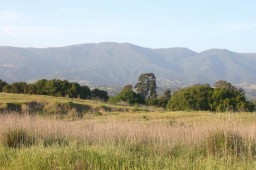

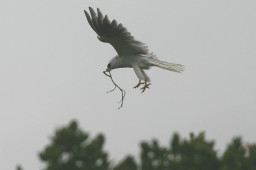
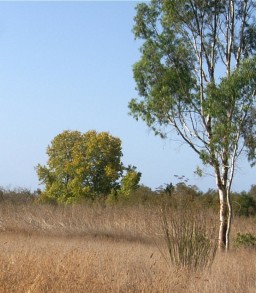

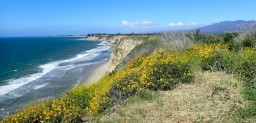

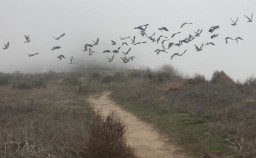 Over the past two months, bird enthusiasts have reported dozens of different bird species on More Mesa in a single, relatively short, visit! Further, of the dozen or more raptor species that MMPC follows on More Mesa, most have been seen in recent months and often with two or more of the species seen at the same time. (Photo courtesy of John McKinney.)
Over the past two months, bird enthusiasts have reported dozens of different bird species on More Mesa in a single, relatively short, visit! Further, of the dozen or more raptor species that MMPC follows on More Mesa, most have been seen in recent months and often with two or more of the species seen at the same time. (Photo courtesy of John McKinney.)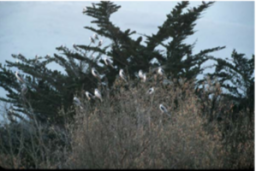 Kites: We are still getting reports of kite roosting behavior with 13-14, and up to 22 birds! Although the 22 were not seen routinely, this number is exciting news for the Goleta Valley, as we have had only one or two kite pairs for many years of the drought.
Kites: We are still getting reports of kite roosting behavior with 13-14, and up to 22 birds! Although the 22 were not seen routinely, this number is exciting news for the Goleta Valley, as we have had only one or two kite pairs for many years of the drought.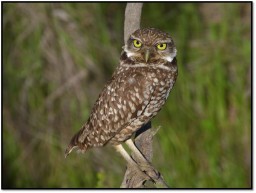 Burrowing Owls: There have been several sightings of two Burrowing Owls … very unusual for this to occur and definitely good news for More Mesa. Burrowing Owls were formerly common in Santa Barbara County, but have been virtually eliminated with only one or two over-wintering birds along the entire South coast. To learn more about these tiny owls (with a definite attitude) see page 35 of the
Burrowing Owls: There have been several sightings of two Burrowing Owls … very unusual for this to occur and definitely good news for More Mesa. Burrowing Owls were formerly common in Santa Barbara County, but have been virtually eliminated with only one or two over-wintering birds along the entire South coast. To learn more about these tiny owls (with a definite attitude) see page 35 of the 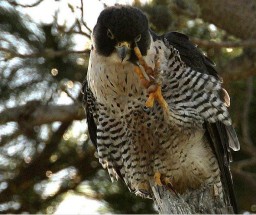 Peregrine Falcons: In addition to so many other birds, we have also seen another raptor not usually seen on More Mesa, the Peregrine Falcon. Like the Coopers Hawk, the principal prey of the Peregrine is birds. Perhaps there is a link here? (Photo courtesy of Larry Friesen.)
Peregrine Falcons: In addition to so many other birds, we have also seen another raptor not usually seen on More Mesa, the Peregrine Falcon. Like the Coopers Hawk, the principal prey of the Peregrine is birds. Perhaps there is a link here? (Photo courtesy of Larry Friesen.) As you visit this special place more often, you will find the spots where your favorite birds can be found. A popular short hike is on the east side (adjacent to Hope Ranch) and starts at the gate on the end of
As you visit this special place more often, you will find the spots where your favorite birds can be found. A popular short hike is on the east side (adjacent to Hope Ranch) and starts at the gate on the end of